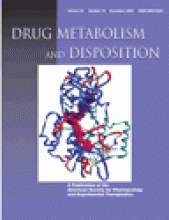Abstract
To characterize the contribution of amino acid 360 to the functional activity of the human flavin-containing monooxygenase form 3 (FMO3) and form 1 (FMO1) in the oxygenation of drugs and chemicals, we expressed four FMO3 variants (i.e., Ala360-FMO3, His360-FMO3, Gln360-FMO3, and Pro360-FMO3) and one FMO1 variant (i.e., Pro360-FMO1) and compared them to wild-type enzymes (Leu360-FMO3 and His360-FMO1, respectively). The amino acid substitutions were introduced into wild-type FMO3 or FMO1 cDNA by site-directed mutagenesis. The thermal stability of variants of Leu360 FMO3 was also studied, and the thermal stability was significantly different from that of wild-type FMO3. The influence of different substrates to modulate the catalytic activity of FMO3 variants was also examined. Selective functional substrate activity was determined with mercaptoimidazole, chlorpromazine, and 10-[(N,N-dimethylaminopentyl)-2-(trifluoromethyl)]phenothiazine. Compared with wild-type FMO3, the Ala360-FMO3 and His360-FMO3 variants were less catalytically efficient for mercaptoimidazole S-oxygenation. N-Oxygenation of chlorpromazine was significantly less catalytically efficient for His360-FMO3 compared with wild-type FMO3. Human Pro360-FMO1 was significantly more catalytically efficient at S-oxygenating mercaptoimidazole and chlorpromazine compared with wild-type FMO1. The data support the mechanism that the Pro360 loci affect thermal stability of FMO3. Because different amino acids at position 360 affect substrate oxygenation in a unique fashion compared with that of FMO3 stimulation, we conclude that the mechanism of stimulation of FMO3 is distinct from that of enzyme catalysis. A molecular model of human FMO3 was also constructed to help explain the results. The increase in catalytic efficiency observed for Pro360 in human FMO3 was also observed when the His of FMO1 was replaced by Pro at loci 360.
Footnotes
-
The financial support of the National Institute of Health (DK59618) is gratefully acknowledged. Vignesh Raman was supported by a grant from the San Diego Foundation and the James Copley Foundation.
-
Article, publication date, and citation information can be found at http://dmd.aspetjournals.org.
-
doi:10.1124/dmd.106.010827.
-
ABBREVIATIONS: FMO, flavin-containing monooxygenase; MBP, maltose-binding fusion protein; MBP-FMO3-His6, C-terminal poly-histidine (His6) fusion protein; SNP, single nucleotide polymorphism, PAGE, polyacrylamide gel electrophoresis; PEG, polyethylene glycol; TMA, trimethylamine; TMA N-oxide, trimethylamine N-oxide; MMI, mercaptoimidazole; 5-DPT, 10-[(N,N-dimethylaminopentyl)-2-(trifluoromethyl)]phenothiazine, DETAPAC, diethylenetriaminepentaacetic acid; HPLC, high-performance liquid chromatography; PDB, Protein Data Bank; ANOVA, analysis of variance; 1get, glutathione reductase; 1npx, NADPH-peroxidase; 1vqw, a protein with similarity to flavin-containing monooxygenases; 1w4x, phenylacetone monooxygenase.
- Received April 25, 2006.
- Accepted September 13, 2006.
- The American Society for Pharmacology and Experimental Therapeutics
DMD articles become freely available 12 months after publication, and remain freely available for 5 years.Non-open access articles that fall outside this five year window are available only to institutional subscribers and current ASPET members, or through the article purchase feature at the bottom of the page.
|






